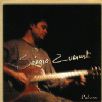Hi! I'm Sergio Zurawski, a Brazilian guitarist, composer and producer. I'd like to talk a little bit about musical creation and production proceedings, using my own experience as an example.
To begin with, I'll talk about my process of composition. Whenever people imagine a musician as he is composing his music, for example, inspired by the full moon of a beautiful night, one of the images that come to their minds is of the musician lazily sitting in the veranda of a cottage, staring at the moon as he says, "I'll compose a song for you, Moon... come forth, inspiration... come forth..."
However under normal influences and interferences of the environment, that's not the way it happens, at least for me. The conception of music for me is provoked by a state of spirit totally subjective, subtle, abstract, transcending, which stimulates me and hastens the fruition of the act of creation.
It's funny that I almost always compose music intuitively; I never have my mind fixed on something, searching for inspiration. I usually take my accoustic guitar, or sit at the piano, and by singing, whistling, or fingering some melody, I let my thoughts flow naturally, free and loose - nothing else on my mind other than the ways the melodies choose to run. Sometimes the musical idea comes complete - which results in a theme created instantaneously. Other ideas I have to work harder, for here and there the fluency of the music comes to a halt. Then I have to waste some time in order to work it out - as we usually say here in Brazil, 'undoing the knot'.
After the music is ready and I have listened to it a few times I usually begin to associate it with images, ideas, or concepts. That's the hardest thing for most composers (myself included) - developing a good title for the music. It's important to remember that if the music is composed for a specific project, such as soundtracks for theater, movie, TV, ballet, etc., it will surely be inspired by the proposed theme.
When the music is ready, it's time to record it. I make use of a Pro Tools system plus Logic Audio, running through a Macintosh platform at UsinaZ, my own project studio. If the music demands an arrangement of complex, elaborate elements I start working in Logic, which gives me full, unlimited MIDI resources. After finishing that phase, having MIDI ready, I export them from Logic . Then I develop a Pro Tools session, import the Logic MIDI files into it, convert them into audio, record the remaining audio (instruments, voices, effects, whatever), after which I conclude my work. If I am in a hurry,and I don't want to waste time, I have the choice of converting all the MIDI tracks into audio at the same time, straight into stereo (L-R) tracks instead of track by track.
If I don't need a tremendous amount of MIDI work, I start and conclude the music in Pro Tools. In case I need to complete my work at any other studio, I record the Pro Tools sessions on a CD-R and take it there, or better, if there are large audio files, I take my own SCSI hard drive and transfer the data to the studio's hard drive. That will only occur, of course, if the studio system is similar to mine, the Pro Tools/Logic Audio/Mac platform. This occurs more often than not, for I am frequently hired to produce just a few tracks of a particular CD or project, which has it's global production centralized in another studio.
Strictly speaking, we can never say there is a fixed rule or an invariable, unchangeable element in that process. It will always depend on the event. "Pulsares", for instance, had been digitally recorded using the ADAT system, and mastered in Pro Tools. We first recorded the drums and the bass, both at the same time, from a MIDI pre-production which was used as a reference guide. Afterwards, we added keyboards, rhythm guitars, percussion, and at last, the guitar solos.
My guitar setup for that CD was: Fender Strato Custom Shop (setneck), Gibson Chet Attckins (steel), Takamine (nylon), JMP-1 Marshall pre-amp, Mesa Boogie Mark IV amp and Lexicon effects. I used the JMP-1 running through the Mesa Boogie "return effects" at the rear panel, in order to use only the power amp. Just a single SM57 Shure (believe it or not!) in front of the speaker was used to capture all the guitar sounds.
At present I have a guitar synth GR33 and a POD Line 6 added to my guitar setup. I have deeply fallen in love with that POD Line 6. It is extremely amazing, as much in live performances as in studios.
Well, that's it! If you have any doubts, questions, or just want to say hello, write to me, it will be my pleasure to send you an answer. See ya then!
A professional musician since 1978, Sergio Zurawski has been working with some of the most important names in Brazilian music and theater in shows, soundtracks and plays. He has also taken part as producer and/or musician in more than 100 records with several artists.
His 2000 instrumental CD is entitled "Pulsares".
